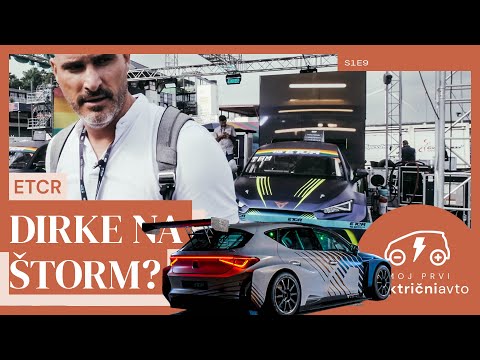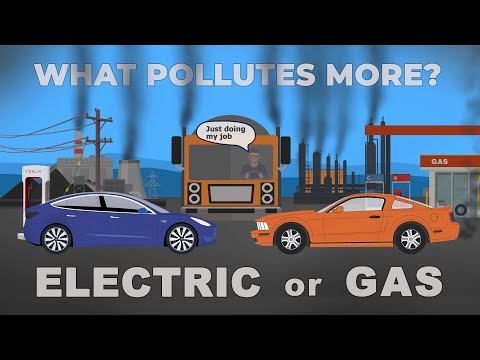The transition to electric vehicles (EV) is not only a response to global environmental challenges, but is primarily a sign of technological progress and new possibilities. Although charging at fast charging stations seems to take only a little longer than conventional refueling, electric cars can actually save us more time throughout the year. In fact, electric car owners spend less time "recharging" energy for their driving than classic car owners. Contrary to popular belief that they are more expensive, electric cars deliver long-term savings thanks to lower maintenance costs and a longer lifespan. So - debunking - debunked myths about electric cars.
A contribution to dispelling the myth of electric cars is absolutely necessary, as we are surrounded by a sea of misinformation and prejudices, which spring from ignorance, many still cling to outdated beliefs. Throughout human history, there is ignorance often gave birth to fear and rejection of innovation, but innovation has proven its worth over and over again. Ironically, many are opposed to change, even though it brings obvious benefits and improvements to our everyday lives.
Ob the beginning of the last century, upon the appearance of the classic car, which represented a technological miracle for the society of the time, many expressed their disapproval, as if the car represented some kind of devil. This groundbreaking innovation equestrian transport, initially caused fear, but eventually became an indispensable part of our lives. Electric cars are experiencing a similar story today, who are surrounded by a lot of ignorance and prejudice. Ironically, history repeats itself - new technologies are initially resisted, and then accepts and idealizes them.
Some arguments against electric vehicle seem as pointless as the attempt convince the crocodile, let it become a vegetarian. Yes, electric vehicles are different, perhaps even misunderstood, with every new technological revolution a period of adjustment is coming. Let this introduction be a reminder that progress is inevitable and that they are electric vehicles here to stay – not just as a symbol of ecological awareness, but as a superior choice for the modern driver. Let's dispel myths with facts and enter the electric future with a smile.

Debunked myths about electric cars
Myth #1: Charging an electric car takes too long
A common opinion is that charging an electric car takes several hours. It is true that home charging can take longer, 4 to 5 hours, but fast charging stations allow most car batteries from 20 % to 80 % to be charged in less than 25 minutes. It is not true that you would survive at the charging station a full 25 minutes. Owners of electric cars at fast charging stations usually fill up only as much energy as they need for the journey home, where electricity is cheaper. A full 25-minute charge (from 20 % to 80 %) is only required for long-distance rides, longer than 350 kilometers, which happen a few times a year. On such trips, there are stops on each 2.5 to 3 hours drive, if not necessary, but desirable for safety, regardless of the type of driving energy of the car. The average driver of an electric car with a realistic range of around one charge 350 kilometers it only needs fast charging about six times a year. Most drivers don't really need a subscription to fast charging providers like for example Ionity, as the need for this charging is small. Electric car owners they usually charge at home, mostly on the usual attached charger, and most of them don't see the need for a more powerful one 11 kWh charging stations. An interesting fact is that the owner of a regular car spends about 8 hours a year filling up fuel at a gas station, which is about 4.5 hours more than the owner of an electric car, who visits a fast charging station six times a year on average and there on average spends about 15 minutes. In countries where fuel is cheaper off the highways, the time loss for classic car users is even greater. Realistically, you waste more time recharging if you own a classic car. Contrary to what the media has taught you, electric car charging is not slow. Users electric vehicles they mostly have always a full tank, when they leave home, so they don't need to stop at the gas station, which is usually the case before a long journey with a classic car. This is also why, surprisingly, they often reach their destination earlier.
Myths #2: Range of electric vehicles
Many believe that electric vehicles cannot travel long distances without charging. However, modern electric vehicles such as Tesla Model 3 with a larger battery, they can travel up to 500 kilometers on a single charge. That's more than enough for most daily commutes, and many people don't go more than 300 kilometers away even on their annual vacation. The average electric car consumes around 20 kWh of electricity per 100 kilometers driven. So you can with a car equipped with 80 kWh battery, in most cases transport 400 kilometers with a single charge. When buying an electric car, an important question is how often per year you plan to drive distances greater than 300 kilometers in one direction. If such trips are infrequent, once or twice a month, a short stop to fill up the car will be an insignificant logistical obstacle. The stops are usually short and only allow for a quick coffee. For those who drive a lot of kilometers every day, it is a diesel car is still the optimal choice. However, many business travelers who drive 50,000 or more kilometers per year are opting for electric vehicles because of the significant savings in energy costs. Drivers who travel really high kilometers use about a third of the cost of energy compared to the cost of driving on fossil fuels.
Myth no. 3: Electric vehicles are too expensive
Although they are initial “nominal” costs are often higher compared to gasoline vehicles, the long-term cost of ownership of electric vehicles, including maintenance and energy, is usually lower. Certain warranties for electric cars are longer than for conventional cars – i.e. for the powertrain and battery. It would be interesting to see a manufacturer that would give a warranty on a classic engine up to 180,000 kilometers. Electric vehicles are basically better equipped than classic ones, which means that it is difficult to buy an electric car without radar cruise control, heated seats and a steering wheel. It is this additional equipment that makes the real difference in price. Electric cars they also automatically offer more horsepower, better acceleration, and often 4×4 drive. If we were to compare these properties directly 1:1 with gasoline or diesel engines - i.e. comparable power, horses and other technical characteristics - you would find that electric cars are already comparably expensive today. Electric cars will also be able to cover more kilometers during the life of the car, it is expected that they will be able to travel at least twice as much. What the vehicles prove in practice Tesla Model S from 2014, 2015, where huge mileages have proven that these are more durable cars that will in principle do more at least 1.8x more in their lifetime than classic cars. So if you're buying a car with more horses, longer life, etc. then it is somehow logical, that the car costs several thousand euros more. One of the main ones in the category of myths about electric cars.
Myth no. 4: Electric vehicles have a shorter range in winter
It's true! Like cars powered by an internal combustion engine, electric vehicles generally consume more in winter. If the average classic car has for 1 to 2 liters higher consumption of gasoline or diesel, then has an electric car for approx 10 to 25 percent higher electricity consumption at low temperatures. This is mostly due to the heating of the passenger cabin and the powertrain components themselves.


Some vehicles such as Tesla, are extremely efficient thanks to the superior heat pump that is part of the system, and only experience a small reduction in range. At Tesla, the increased consumption due to low temperatures is currently 15 percent of the intended range, which can be compared to classic cars, which also consume more in sub-freezing temperatures. At the same time, in winter we drive to classic winter tires, which, regardless of the type of car, reduce its range. Another refutation – myths about electric cars.
Myth no. 5: Electric vehicles do not have enough power
There is a belief that electric vehicles cannot provide the power and performance that traditional internal combustion engine vehicles offer. However, electric vehicles such as Tesla Cybertruck, prove that they can offer exceptional acceleration as well as towing capacity. It is true that consumption, just like with classic cars, is also higher with electric cars when they are towing a caravan, for example. A similar rule applies here as in winter, that regardless of the type of car, consumption will be increased when towing itself, for example a caravan. It should be emphasized that electric vehicles have instant torque and more horsepower, which generally makes them more suitable for hauling loads when it comes to pulling power. Of course, everyone will have to 200 kilometers to fill up "energy", which represents certain minus, but once or twice a year is definitely not too much of a hurdle. In terms of power and torque, electric vehicles are definitely ahead of classic cars.
Myth #6: Batteries fail, lose power, and the replacement cost is high
Among the most widespread myths is concern about battery life in electric vehicles, which in principle is unnecessary. Modern lithium-ion batteries are designed for long-term use and often have a very long warranty. Battery technologies have really been refined and greatly improved in recent years. The average manufacturer's warranty on batteries is 8 years or 180,000 kilometers, which applies to both electric powertrains and the vehicle's battery. Since most used electric cars are also relatively new, there are not as many of these problems as it might seem at first glance due to the many falsehoods and myths about batteries. In principle, based on the experience of Tesla owners and statistics (the brand with the most mileage), changing the battery pack "can" occurs somewhere after 300,000 kilometers. However, the battery can be restored or services in a manner, to identify the problem and replace only the cell that caused the problem, i.e. the weak battery cell responsible for the failure indication. These services are not cheap, but they are not overly expensive either. Also, there are "refurbished" batteries on the market at a much lower price, which are renewed and on which you get a certain warranty. The life span of electric cars is generally longer than conventional ones with an internal engine combustion (ICE). The fact is that it is necessary to handle the car battery correctly in order to ensure its longevity and durability. Tesla's claims are that their cars with existing technologies could do 500,000 kilometers with degradation batteries under 20%, if the owner follows all the rules for charging the battery. These are not just myths, but have been repeatedly proven in practice. Realistically, it should average battery and its usefulness already exceeded the average lifespan of a classic car. According to many independent studies, the surprising data is that the average mileage of an internal combustion engine vehicle is approx. 214,000 kilometers (133,000 miles). Experts estimate that the average battery life of an electric vehicle is around 321,800 kilometers (200,000 miles), and some manufacturers are already promising much more than that. Nevertheless, it should be emphasized that there is already a market for used batteries with guarantees or the possibility of buying them for use in another life cycle. So, you will be able to sell a used battery for about a third of the value of a new battery and decide whether to get a refurbished or a new battery when the need arises. exchange and the car will be out of warranty.
Myth #7: Used batteries cannot be recycled in an environmentally friendly way
The majority used electric car batteries will change to in the future electricity storage facilities for domestic solar power plants, where the old heating oil tank will be replaced in the "heating rooms". They will serve for a complete "off-grid" experience. Currently, the greatest demand is for BMW i3 batteries, which are proverbially excellent for this kind of matter, and are already used by transition enthusiasts as storage tanks and complete independence from the "network". Batteries that will be damaged or completely worn out, of course, have the possibility of recycling their elements and giving them a new life in other batteries.
Myth #8: There are not enough fast charging stations
A lot of people think so charging infrastructure is insufficient. However, the number of charging stations is constantly increasing, and the possibilities of charging at home are also improving. The average owner of an electric car, which can travel 350 kilometers on a single charge, will statistically only need a fast charger 6 times a year. At that time, he will supply the energy he needs to reach his destination at the charging station, and on average he will not stay at the charging station for more than 15 minutes. Also, the driver will decide that he would prefer to pour energy at a fast charging station classic "city" electric charging stations at the destination itself, i.e. at various parking lots and other charging points. However, many of us agree that the number of charging stations will be crucial in the future, and that is why Tesla is rapidly expanding its network of charging points and enables charging for other brands as well. This increases the availability of fast chargers exponentially.
Myth #9: Electric vehicles cause more environmental damage than classic ones
Research shows that electric vehicles are "greener" than conventional vehicles, but the tipping point at which they become more environmentally friendly varies greatly depending on several factors, including how of electricity production, which is used to charge them and make batteries.
Research from Argonne National Laboratory in Chicago, using the GREET (Greenhouse Gases, Regulated Emissions, and Energy Use in Technologies) model, points out that the production of electric vehicles generates more carbon emissions than vehicles with internal combustion engines, mainly due to the extraction and processing of minerals for EV batteries and production of the cells themselves. However, once the vehicle leaves the production line, EVs generally emit significantly less carbon emissions over their lifetime. The tipping point at which EVs become more environmentally friendly than gasoline vehicles can vary widely. In countries like Norway, where almost all electricity comes from renewable sources, this tipping point can be as little as 8,400 miles. By comparison, in countries where most electricity is generated from coal, an EV would need to be driven up to 78,700 miles to reach carbon parity with a gasoline vehicle.
A study by the German Federal Environment Agency (UBA) states that electric vehicles registered in 2020 are approximately 40% more environmentally friendly than vehicles with gasoline engines. This advantage is predicted to grow to around 55% for vehicles registered in 2030 as renewable technologies advance.
Research by the MIT Climate Portal finds that most emissions from today's EVs come after they leave the production line, with the main source of emissions being the energy used to charge their batteries. These emissions vary greatly depending on where the vehicle is driven and what type of energy is used there. In countries with low-carbon electricity production, such as Norway, EVs have a negligible carbon footprint. In countries where coal is mostly used for electricity generation, EV emissions are not as favorable, but they are still comparable or better than gasoline vehicles.
However, it is important to point out that many of these studies do not fully account for the energy used to “distill” the oil into a fuel that is safe for use in internal combustion vehicles. This process of fuel production and distribution is in itself energy-intensive and thus associated with additional emissions that should be included in the comprehensive analysis of the vehicles' environmental footprint. This aspect is often overlooked in research, which can lead to a misunderstanding of the actual environmental impact of electric vehicles compared to internal combustion vehicles.
Nevertheless, when all factors are taken into account – from production to end of life – it is clear that EVs generally produce at least 50% less pollution compared to internal combustion vehicles over a lifetime. This advantage can be further increased if the electric vehicle has a longer lifespan, which would mean even less pollution compared to ICE vehicles. The development of cleaner methods of electricity generation and advances in battery technology will further improve the environmental profile of electric vehicles, cementing their role as a key element in the transition to a more sustainable and less polluting transport system.
Myth #9: Electric vehicles are dangerous in traffic accidents because they like to catch fire.
The myth that electric vehicles (EVs) are more dangerous in traffic accidents due to batteries and fire risks is one of the most common misconceptions about electric cars. The truth is that electric vehicles are subject to the same, if not more stringent, safety tests as internal combustion (ICE) vehicles. They often even exceed safety standards, as evidenced by the results of Euro NCAP tests, which are the reference point for evaluating vehicle safety in Europe.
Safety research and tests, such as those carried out by Euro NCAP, show that electric vehicles achieve high safety scores. For example, the Tesla Model 3, one of the most popular electric vehicles, received one of the highest safety ratings ever awarded by Euro NCAP. Other electric vehicles such as the Audi e-tron, Volvo XC40 Recharge and Nissan Leaf also received similarly high safety ratings.
Regarding fire risk, studies show that electric vehicles are actually less prone to fires than internal combustion vehicles. According to research published in the journal "Battery Fires: The Electric Vehicle's Hot Potato", the probability of a fire in electric vehicles is estimated to be about 80% less compared to ICE vehicles. This is mainly due to the fact that electric vehicles do not contain highly flammable liquids such as petrol or diesel.
However, when a battery ignites, it can be a challenge due to the nature of the lithium-ion batteries used in most EVs. However, modern battery management systems are designed to minimize the risk of thermal breakdown, which can lead to fire. In addition, EV manufacturers include advanced safety features to protect battery packs in the event of a crash.
Interestingly, studies show that it is actually hybrid vehicles that combine an electric powertrain with an internal combustion engine that are more likely to cause fires compared to purely electric or ICE vehicles. This is due in part to the fact that hybrid vehicles contain both a battery pack and a fuel tank, increasing potential ignition sources.
In conclusion, electric vehicles not only meet safety standards, but often exceed expectations, as evidenced by their high scores in safety tests. Although there is a risk of fire with batteries, it is significantly less compared to internal combustion vehicles. Modern technology and safety innovations continue to reduce this risk, making electric vehicles among the safest options on the market.
#Mit #10: Electric vehicles are difficult to maintain
The myth of the high cost and complexity of electric vehicle (EV) maintenance is indeed one of the misconceptions that often appear in the public eye. As stated, electric vehicles require less regular maintenance due to their simpler design with fewer moving parts compared to internal combustion (ICE) vehicles. This is reflected in lower maintenance costs and a lower probability of unforeseen breakdowns.
The fact that electric vehicles do not need regular oil changes, filter replacement, spark plugs, brake pads (due to regenerative braking, which puts less strain on the brake systems), helps to significantly reduce maintenance costs. This is especially important when considering the long-term costs of vehicle ownership.
Research and statistics, such as those conducted by Consumer Reports and AAA, confirm that the total cost of ownership of electric vehicles, when factoring in purchase price, subsidies, energy costs for propulsion and maintenance, is more affordable in the long run compared to ICEs vehicles. This not only dispels the myth of expensive and complicated maintenance, but also emphasizes the economic efficiency and reliability of electric vehicles as a long-term investment.
In addition to EVs being a cheaper option for owners in terms of maintenance costs, their upfront investment is gradually becoming less of a barrier as subsidies and lower battery costs make electric vehicles more financially affordable. As knowledge of the benefits and efficiency of electric vehicles continues to expand, consumer acceptance of these vehicles is likely to increase as well.
In short, electric vehicles not only represent a more environmentally friendly choice, but are also an economical choice for consumers looking for vehicles with lower long-term ownership and maintenance costs. As such, the myth of EVs being difficult to maintain is gradually losing its validity as consumers and the industry gain a better understanding and experience with EVs.
Myth #11: Electric motors are inefficient
The myth that electric motors are inefficient is false. Electric motors are significantly more energy efficient compared to internal combustion engines (ICE). The average energy efficiency of an electric motor is around 85-90 %, which means that most of the energy coming from the battery is directly converted into driving power. In contrast, ICE engines have an efficiency of about 20-30 %, which means that a large proportion of the energy obtained from fossil fuels is lost in the form of heat, friction and other inefficiencies during the combustion process. This large difference in efficiency can be attributed primarily to the simpler and more direct transmission mechanics of electric vehicles, which do not require a complex combustion process to produce power. This high energy efficiency of electric motors not only increases the vehicle's range per battery charge, but also reduces operating costs and greenhouse gas emissions, making electric vehicles a more attractive and environmentally friendly choice compared to their ICE counterparts.
Myth #12: Electric vehicles will overload the power system
Concerns that the mass adoption of electric vehicles (EVs) would overload the power system are understandable, but these concerns appear to be largely unfounded. Studies such as the one conducted by the US National Renewable Energy Laboratory (NREL) show that electric vehicles actually offer opportunities to improve and stabilize the power grid, thanks to smart charging and energy storage technologies. Smart charging allows EVs to charge during times of low electricity demand and high renewable generation, helping to balance grid loads and improve grid efficiency.
In addition, the concept of vehicle as storage (V2G - Vehicle to Grid) represents a revolutionary possibility, where EVs act not only as energy consumers, but also as mobile storages that can transmit energy back to the grid at key moments. This would make it possible to balance demand and supply in the network and contribute to greater stability and reliability of the electrical system. Research conducted by the University of Delaware shows that V2G technology could significantly reduce the need to invest in new electricity generation and distribution infrastructure, as electric vehicles could absorb excess energy and feed it back into the grid as needed.
Thus, electric vehicles do not represent a threat to the power system, but rather an opportunity for its optimization. With smart charging and V2G technologies, EVs can play a key role in balancing the grid and ensuring a greener and more efficient future for the energy system. It is also important to note that advances in energy storage technologies and an increase in the share of renewable energy sources in the energy mix further reduce the risk of grid overload due to electric vehicles.
Myths #13: We are switching to electric cars because of global warming
The debate about the transition to electric vehicles (EVs) is often colored by green arguments and concern for the environment, but in reality it is about much more than just the fight against global warming. At the heart of this transition is progress – technological development that promises vehicles with better energy efficiency, longer lifespans and ultimately less impact on the environment. Electric vehicles actually produce at least 50 percent less emissions (2024) over their lifetime compared to internal combustion vehicles, but the advantage of electrifying transportation is not just about the ecological benefits.
The technological development behind EVs opens the door to new possibilities and opportunities for economic growth. This is one of the key reasons why countries like China are strongly promoting electrification. It is an opportunity to take leading positions in the global market of new technologies, which can bring significant economic benefits and create new jobs. In addition, the technological development of EVs enables the improvement of infrastructure such as smart grids and energy storage technologies, which further contribute to the stability and efficiency of the energy system.
Electrification of transport therefore represents a step forward not only in the field of environmental protection, but also in the field of innovation and technological development. This transition is not only a response to environmental challenges, but also an opportunity to create a sustainable, economically prosperous future that will bring benefits to various areas of society.
Conclusion: the electric car is the future because its technology is the future
We are switching to electric cars not because of ecology, but because of technological progress. Filling up at fast charging stations, which takes just over 10 minutes, represents a significant time saving compared to the time we spend a year filling up oil in classic cars. Electric cars, which are cheaper in the long run and have a longer lifespan, reveal that most of the preconceptions about e-mobility are the result of extensive ignorance. The negative emotions that come with not knowing are a reaction to change, which, if we look at it objectively, is often in our favor.
Just as our ancestors had to learn to accept the classic car as part of the new reality, we too must open up to the possibilities brought by the electrification of transport. It is not about "green" technologies because of a political agenda, but because of the opportunities for economic growth and technological development that this transition makes possible. Simply put, it is a technological development. China, which is strongly promoting electrification, sees this as an opportunity for a new wave of economic growth. However, as always in human history, the first step is to overcome ignorance and open yourself to progress.
















